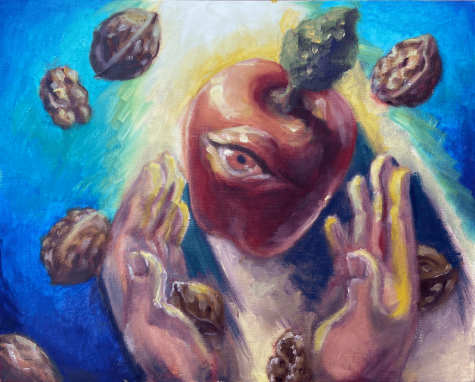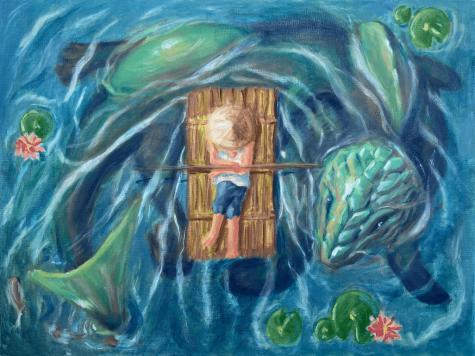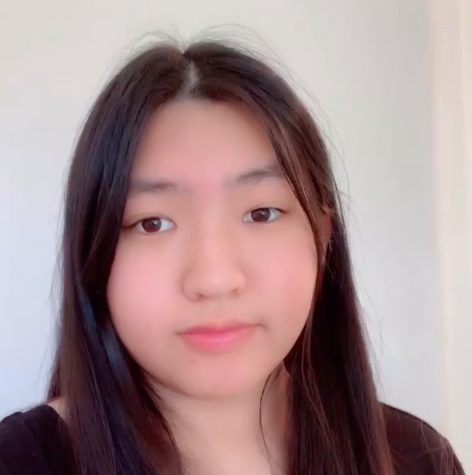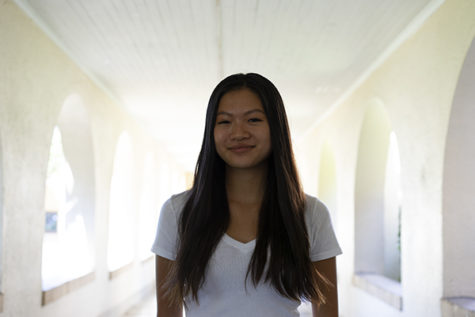Featured Artist: Faustine Wang
Faustine Wang combines her many passions of art, technology and service to make lasting effects on the world.

Art by Faustine Wang
The video game opens with a splash screen of a cute kangaroo in a grassy field. The simple, blocky art style is paired with a light and energetic tune playing in the background as you navigate through the simple interface. As you scroll through the list of animal characters, a customized placard accompanies each animation, detailing information about themselves, such as name, type and special moves. After making your selection, your chosen character is transported to an open field with floating platforms and stands in front of an opponent. Then, the game immediately begins. You effortlessly shuffle and jump using the arrow keys with the objective to jump on the other player’s character and beat them. The player left after the other player’s character disappears has their character highlighted with the screen displaying who wins.
This is the indie game “Bounce Battle,” created by Paly senior Faustine Wang in mid-August.
Wang began developing her artistic abilities as a toddler with markers and scratch paper always in hand, making doodles. As she grew older, art became an increasingly important outlet. “I’ve seen it as a source for me to document my imaginations and create something out of my daydreaming,” Wang said.
Having grown up in the heart of Silicon Valley, Wang has been immersed in the world of technology her whole life and more recently developed a fascination with the connection between art and game design. She especially admires how video games allow users to closely interact with art and directly affect how it looks.
“I’ve seen YouTube channels that are dedicated to just video game art,” Wang said. “A video game needs to focus on functionality in addition to having it look good, so you have to be conscious of everything.”
But prior to the summer entering senior year, Wang did not have a lot of coding experience. Taking AP Computer Science Principles helped her learn the basics of coding, which enabled her to pursue making a video game.
However, Wang still had to supplement her coding experience outside of class. She watched tutorials online, which helped further develop her C# skills—the coding language used by the game engine Unity.
Wang spent about four months coding the game, but there were still many bugs left in the code that she had to fix. She constantly needed to review and make reiterations to her work, parallel to her experience in artistic processes.
“You see this iterative process in a lot of creative processes in art too,” Wang said.
Although this is Wang’s first animated project, she hopes to use this experience as a practice opportunity to enhance her coding and artistic skills.
“Right now, it’s like a practice project,” Wang said. “[It is] a step toward the other video games I want to make.”
Through this project, Wang was able to combine her love for art and video game design. In the future, she plans to continue merging her fields of interest, such as psychology and cognitive science, to create her own unique path in life.
“Cognitive science is an interdisciplinary [field] between psychology, computer science, and I feel like it encapsulates my interests a lot,” Wang said. “While I study at university about these things, they can really provide me with more insight and materials for me to do art.”
Beyond a medium to express her creativity, Wang uses art’s ability to build and support communities.
Wang collaborated with her friends to found Artruism, a service-oriented Paly club that fundraises for different causes through commissioning art. In addition to the communal impacts, Wang also wants Artruism to be a welcoming platform and organization for student artists.
“People who share their passions come together to do art,” Wang said. “Part of my nonprofit’s mission is to build a community of artists in addition to promoting our different causes.”
Whether she is combining her fascination for computer science, service or other artists in her own artistic pursuits, Wang always strives to use her art for good and help others understand and share her passion for art.
“Sometimes there’s a misconception about how art is not useful in a way,” Wang said. “But [my art projects] represent the value that I put on art and help share that with other people.”
Art pieces
One of Wang’s most recent pieces entitled “Wisdom” is a Renaissance-inspired oil painting that illustrates two hands reaching towards an apple with an eye and has walnuts scattered throughout the background. For Wang, it symbolizes the nuance of knowledge and wisdom.
“I explore the idea that true wisdom is difficult to obtain even in abundance of knowledge. The apple represents wisdom and the walnuts represent the knowledge.”

Wang’s grayscale drawing “Eureka” portrays a human figure with a lightbulb for a head with small figures polishing the glass. Wang includes optical illusions such as impossible triangles and staircases—a nod to Maurits Cornelis Escher’s art which is known to incorporate similarly mind-boggling imagery.

“I wanted to play with optical illusions in Eureka, and also depict the monotony of a modern corporate lifestyle, looking at perceptions of the world and of one’s personal life.”
At the beginning of the pandemic, students were all dealing with the ensuing disorder of the world. Wang turned her energy to creating an oil painting called “Serenity,” which depicts a figure with a wide-brimmed hat floating on a wooden raft in a pond filled with majestic aquatic creatures.
“I wanted to depict a calmness within chaos, alluding to Taoist beliefs about circularity.”


I joined C Mag because I wanted to further explore journalism writing, and C Mag allows me to write about topics that I’m personally interested in. My...

2019-2020 - Staff Writer
2020-2021 - Managing Editor
Hear more about me!









